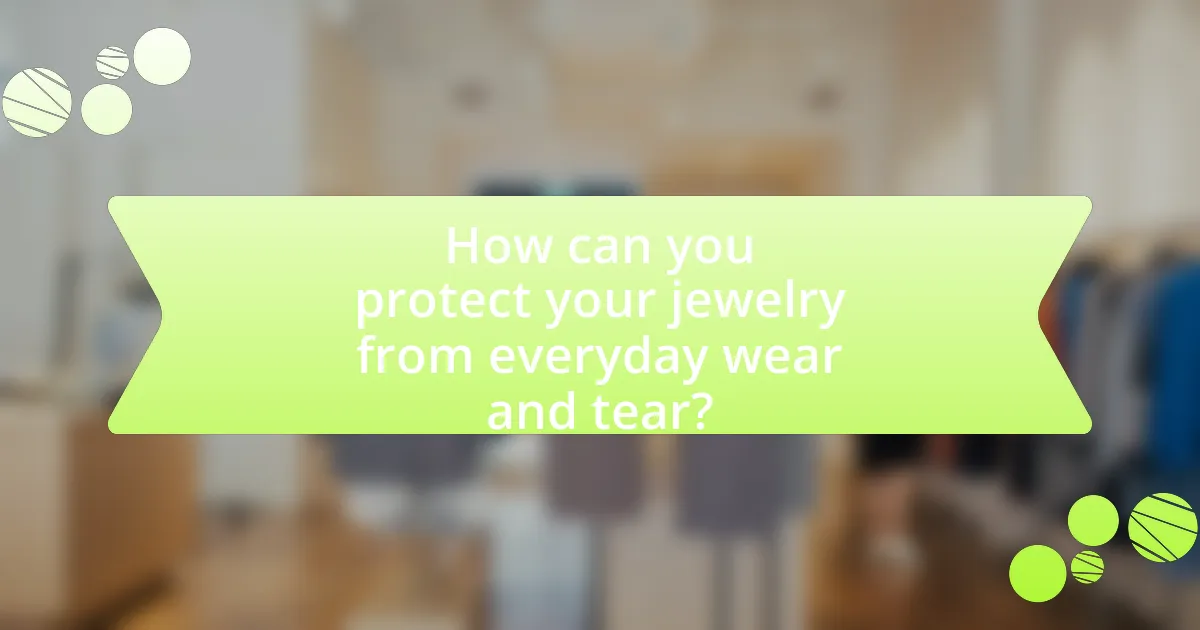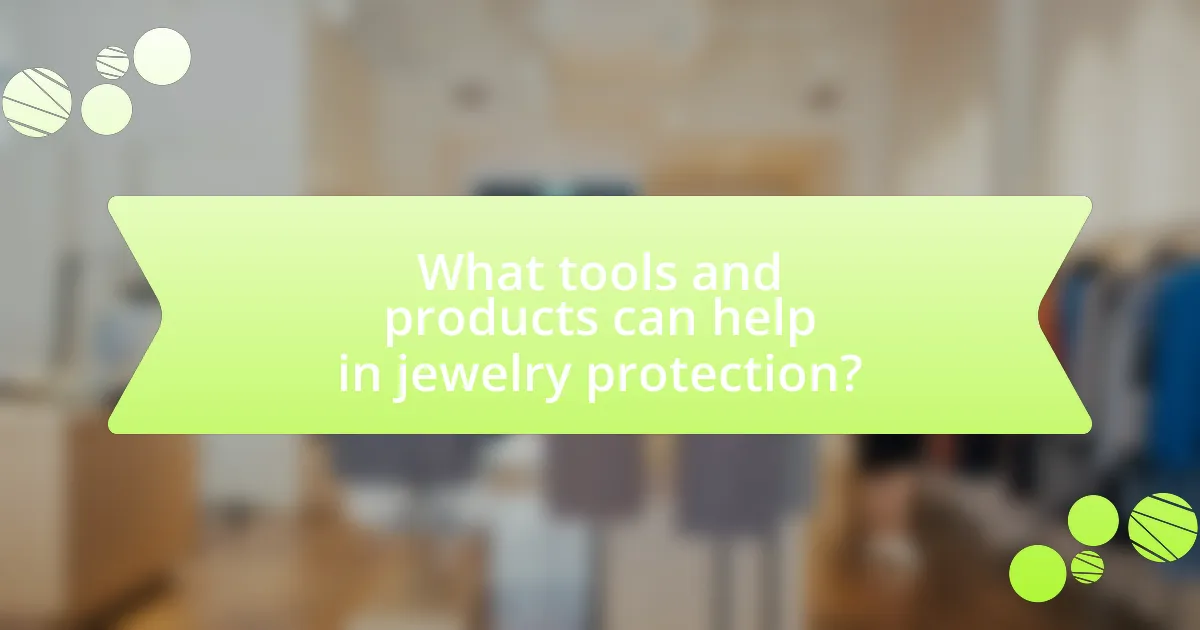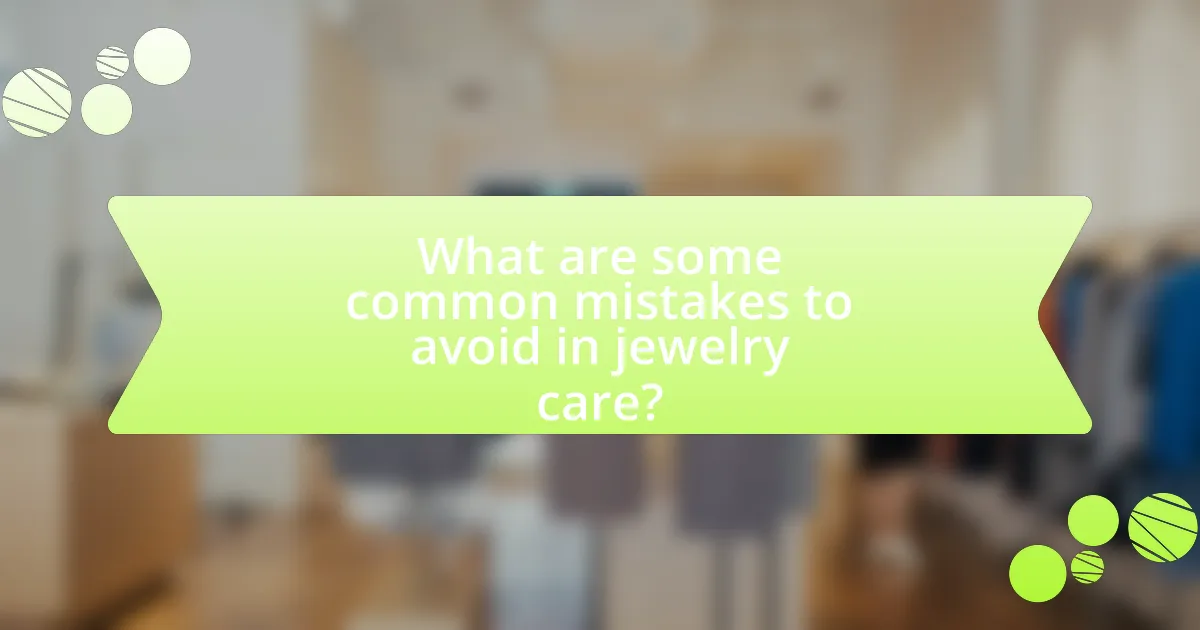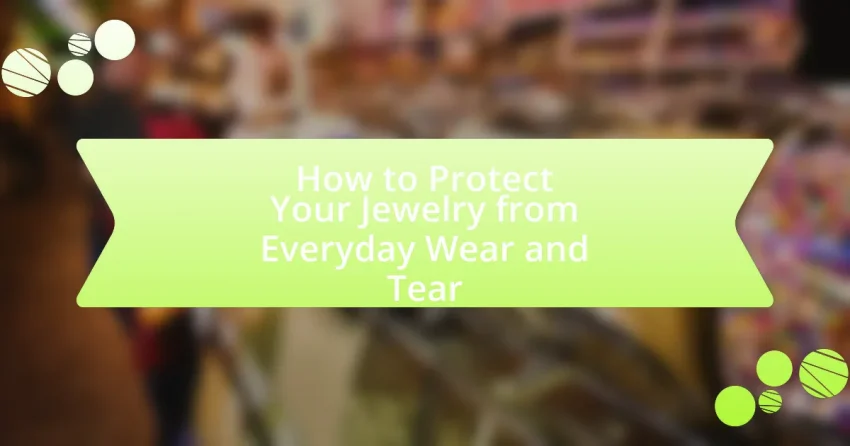The article focuses on effective strategies for protecting jewelry from everyday wear and tear. It outlines common causes of damage, such as exposure to chemicals, physical abrasion, and environmental factors, and emphasizes the importance of proper care and maintenance. Key practices include storing jewelry in soft-lined boxes, removing it during physical activities, and regular cleaning to extend its lifespan. Additionally, the article discusses the benefits of protective coatings, safe cleaning methods, and the significance of avoiding common mistakes in jewelry care. Overall, it provides practical tips to maintain the integrity and value of jewelry over time.

How can you protect your jewelry from everyday wear and tear?
To protect your jewelry from everyday wear and tear, store it in a soft-lined jewelry box or pouch to prevent scratches and tangling. This method is effective because it minimizes exposure to dust and other abrasive materials that can damage the surface of the jewelry. Additionally, remove jewelry before engaging in activities such as exercising, cleaning, or swimming, as these actions can lead to physical damage or exposure to harsh chemicals. Studies show that regular maintenance, such as cleaning with a gentle solution and polishing, can extend the life of jewelry by removing buildup that can cause deterioration.
What are the common causes of wear and tear on jewelry?
The common causes of wear and tear on jewelry include exposure to chemicals, physical abrasion, and environmental factors. Chemicals such as perfumes, lotions, and cleaning agents can corrode metals and damage gemstones. Physical abrasion occurs when jewelry rubs against hard surfaces or other jewelry, leading to scratches and loss of luster. Environmental factors like humidity, temperature fluctuations, and exposure to sunlight can also degrade materials over time, causing discoloration and weakening structural integrity. These factors collectively contribute to the deterioration of jewelry, necessitating proper care and maintenance to prolong its lifespan.
How does daily exposure to elements affect jewelry durability?
Daily exposure to elements significantly reduces jewelry durability. Factors such as moisture, heat, and chemicals can lead to tarnishing, corrosion, and structural damage. For instance, exposure to saltwater can cause silver to tarnish rapidly, while chlorine can weaken gold and platinum settings. Additionally, UV rays can fade gemstones and weaken adhesives used in jewelry. Studies have shown that prolonged exposure to these elements can decrease the lifespan of jewelry by up to 50%, emphasizing the importance of proper care and protection.
What types of activities contribute to jewelry damage?
Activities that contribute to jewelry damage include exposure to harsh chemicals, physical impacts, and improper storage. Harsh chemicals, such as those found in cleaning products, can corrode metals and dull gemstones. Physical impacts, like bumping jewelry against hard surfaces during sports or manual labor, can cause scratches or breakage. Additionally, improper storage, such as leaving jewelry in piles or in damp areas, can lead to tangling, scratching, or tarnishing. These activities are well-documented in jewelry care guidelines, emphasizing the importance of careful handling and maintenance to preserve the integrity of jewelry.
Why is it important to maintain jewelry care?
Maintaining jewelry care is important because it preserves the integrity and appearance of the pieces over time. Regular cleaning and proper storage prevent tarnishing, scratching, and damage, which can diminish the value and aesthetic appeal of jewelry. For instance, gold and silver can tarnish when exposed to moisture and air, while gemstones can lose their luster if not cleaned properly. According to a study by the Gemological Institute of America, proper maintenance can extend the lifespan of jewelry significantly, ensuring that it remains a cherished item for years.
What are the long-term benefits of protecting your jewelry?
Protecting your jewelry offers long-term benefits such as maintaining its value, preserving its appearance, and extending its lifespan. By safeguarding jewelry from scratches, tarnishing, and damage, owners can ensure that their pieces retain their original beauty and market value over time. For instance, a well-maintained diamond ring can appreciate in value, while a neglected one may lose its luster and worth. Additionally, regular protection measures, such as proper storage and cleaning, can prevent costly repairs and replacements, ultimately saving money in the long run.
How does proper care enhance the value of your jewelry?
Proper care enhances the value of your jewelry by maintaining its condition and appearance, which directly influences its market worth. Regular cleaning, safe storage, and avoiding exposure to harsh chemicals prevent damage and wear, preserving the jewelry’s original luster and structural integrity. For instance, a study by the Gemological Institute of America indicates that well-maintained jewelry can retain up to 80% of its retail value, while neglected pieces may lose significant value due to scratches, tarnishing, or missing stones. Thus, consistent care not only prolongs the life of the jewelry but also ensures it remains a valuable asset.
What are the best practices for protecting different types of jewelry?
To protect different types of jewelry, it is essential to follow specific best practices tailored to each material. For gold and silver jewelry, regular cleaning with a soft cloth prevents tarnishing and maintains shine. For gemstones, storing them separately in soft pouches or compartments avoids scratches and damage. Pearls require special care; they should be wiped with a damp cloth after wearing and stored in a cool, dry place to prevent drying out. Additionally, avoiding exposure to harsh chemicals, such as those found in cleaning products, is crucial for all types of jewelry, as these can cause irreversible damage. These practices are supported by industry guidelines from jewelers and gemologists, emphasizing the importance of proper care to extend the lifespan of jewelry.
How should you care for rings to prevent scratches and damage?
To care for rings and prevent scratches and damage, store them separately in a soft-lined jewelry box or pouch. This method minimizes contact with other jewelry, which can cause scratches. Additionally, remove rings before engaging in activities that may expose them to harsh chemicals or physical impact, such as cleaning, exercising, or swimming. Regularly clean rings with a gentle soap solution and a soft cloth to maintain their shine and remove dirt. According to the Gemological Institute of America, proper storage and cleaning significantly extend the lifespan of jewelry, confirming the effectiveness of these care practices.
What specific precautions should be taken for necklaces and bracelets?
To protect necklaces and bracelets, avoid exposing them to harsh chemicals, moisture, and extreme temperatures. Chemicals found in household cleaners, perfumes, and lotions can damage the metal and stones, while moisture can lead to tarnishing and corrosion. Additionally, storing necklaces and bracelets separately in a dry, cool place prevents tangling and scratching. According to the Jewelers of America, proper care can extend the life of jewelry significantly, emphasizing the importance of these precautions.

What tools and products can help in jewelry protection?
To protect jewelry from everyday wear and tear, several tools and products are effective. Jewelry boxes with soft lining prevent scratches and damage, while anti-tarnish pouches and cloths help maintain the shine of metals. Additionally, ultrasonic cleaners can safely remove dirt and grime, ensuring jewelry remains in pristine condition. Research indicates that proper storage and cleaning significantly extend the lifespan of jewelry, with studies showing that regular maintenance can reduce wear by up to 50%.
What cleaning supplies are safe for jewelry maintenance?
Safe cleaning supplies for jewelry maintenance include mild dish soap, warm water, and a soft cloth. These supplies effectively clean most types of jewelry without causing damage. For example, a solution of mild dish soap mixed with warm water can safely remove dirt and oils from gold, silver, and platinum jewelry. Additionally, using a soft cloth helps prevent scratches while polishing the surface. Avoid harsh chemicals, abrasive cleaners, or ultrasonic cleaners, as they can harm delicate stones and finishes.
How do different cleaning methods affect various materials?
Different cleaning methods can significantly affect various materials used in jewelry. For instance, ultrasonic cleaning is effective for metals like gold and silver, as it removes dirt and grime without scratching the surface. However, this method can damage softer stones like opals and pearls, which are sensitive to vibrations and heat. Steam cleaning is safe for most metals but can cause fractures in porous stones such as turquoise. Chemical cleaners can tarnish or corrode certain metals, particularly if they contain harsh acids, while gentle soap and water solutions are generally safe for all materials. The impact of these cleaning methods is supported by the fact that jewelry care guidelines often recommend specific cleaning techniques based on the material composition to prevent damage.
What are the best storage solutions for preventing damage?
The best storage solutions for preventing damage to jewelry include using padded jewelry boxes, anti-tarnish pouches, and individual compartments. Padded jewelry boxes protect pieces from scratches and impacts, while anti-tarnish pouches prevent oxidation and tarnishing of metals. Individual compartments help avoid tangling and scratching between items. According to the Jewelers of America, proper storage can significantly extend the life of jewelry by minimizing exposure to elements that cause wear and tear.
How can you use protective coatings or treatments?
Protective coatings or treatments can be applied to jewelry to enhance its durability and resistance to wear and tear. These coatings, such as clear lacquer or specialized jewelry sealants, create a barrier that prevents scratches, tarnishing, and corrosion. For instance, applying a clear lacquer can protect metal surfaces from oxidation, while a polymer-based sealant can shield gemstones from scratches and dirt accumulation. Studies have shown that jewelry treated with protective coatings can maintain its appearance longer, reducing the frequency of polishing and maintenance required.
What types of coatings are available for jewelry protection?
There are several types of coatings available for jewelry protection, including rhodium plating, gold plating, and clear protective coatings. Rhodium plating is a popular choice for silver and white gold jewelry, as it provides a reflective finish and enhances durability against scratches and tarnishing. Gold plating involves applying a thin layer of gold over a base metal, offering a luxurious appearance while protecting the underlying material. Clear protective coatings, often made from acrylic or polyurethane, create a barrier against moisture and environmental factors, helping to prevent tarnishing and wear. These coatings are widely used in the jewelry industry to extend the lifespan and maintain the aesthetic appeal of various jewelry pieces.
How effective are these coatings in preventing wear and tear?
Coatings are highly effective in preventing wear and tear on jewelry. These protective layers, such as rhodium plating or clear polymer coatings, significantly enhance durability by providing a barrier against scratches, tarnishing, and environmental damage. For instance, rhodium plating can increase the lifespan of white gold jewelry by preventing oxidation and maintaining its shine, while polymer coatings can resist scratches and abrasions, thereby preserving the underlying metal. Studies have shown that jewelry with protective coatings can last several times longer than uncoated pieces, demonstrating their effectiveness in minimizing wear and tear.

What are some common mistakes to avoid in jewelry care?
Common mistakes to avoid in jewelry care include improper storage, neglecting regular cleaning, and exposing jewelry to harsh chemicals. Storing jewelry in a cluttered environment can lead to scratches and tangling; therefore, using individual pouches or a dedicated jewelry box is essential. Regular cleaning is crucial, as dirt and oils can accumulate, dulling the appearance of the jewelry; using a soft cloth and appropriate cleaning solutions can help maintain its shine. Additionally, exposing jewelry to harsh chemicals found in household cleaners or swimming pools can damage metals and stones, so it is advisable to remove jewelry before engaging in such activities.
What habits can lead to increased wear on jewelry?
Habits that can lead to increased wear on jewelry include frequent exposure to harsh chemicals, wearing jewelry during physical activities, and neglecting proper storage. Harsh chemicals found in cleaning products, lotions, and perfumes can cause tarnishing and damage to the metal and stones. Engaging in physical activities, such as exercising or doing manual labor, can result in scratches, bending, or breaking of the jewelry. Additionally, improper storage, such as leaving jewelry in piles or exposed to moisture, can lead to tangling, scratching, and overall deterioration. These habits contribute to the accelerated wear and tear of jewelry, reducing its lifespan and appearance.
How does improper storage contribute to jewelry damage?
Improper storage contributes to jewelry damage by exposing pieces to environmental factors and physical stress that can lead to tarnishing, scratching, and structural weakening. For instance, storing jewelry in damp areas can accelerate oxidation, causing metals to tarnish, while placing items in a disorganized manner can result in scratches and tangling. According to a study by the Gemological Institute of America, improper storage practices significantly increase the likelihood of damage, highlighting the importance of using appropriate storage solutions like anti-tarnish pouches and individual compartments to maintain jewelry integrity.
What should you avoid when cleaning your jewelry?
When cleaning your jewelry, you should avoid using harsh chemicals and abrasive materials. Harsh chemicals, such as bleach or ammonia, can damage the metal and stones, leading to discoloration or deterioration. Abrasive materials, like rough cloths or scrubbing brushes, can scratch delicate surfaces, compromising the jewelry’s appearance. It is essential to use gentle cleaning solutions specifically designed for jewelry and soft, lint-free cloths to maintain the integrity and shine of your pieces.
How can you identify signs of wear and tear on your jewelry?
To identify signs of wear and tear on your jewelry, examine it for visible scratches, dents, or discoloration. These indicators often reveal that the jewelry has been subjected to regular use and may require maintenance. Additionally, check for loose stones or clasps, as these can compromise the integrity of the piece. Regular inspections can help catch these issues early, preventing further damage.
What are the early warning signs that your jewelry needs attention?
The early warning signs that your jewelry needs attention include visible scratches, loose stones, and tarnishing. Scratches on the surface indicate wear and can compromise the integrity of the piece. Loose stones suggest that the setting may be weakening, increasing the risk of losing the gem. Tarnishing, often seen in silver and gold jewelry, signals that the metal is reacting with moisture or air, which can lead to further deterioration if not addressed. Regular inspections for these signs can help maintain the jewelry’s condition and longevity.
How can you assess the condition of your jewelry regularly?
To assess the condition of your jewelry regularly, examine it visually for signs of wear, such as scratches, loose stones, or tarnishing. Regular inspections help identify issues early, allowing for timely repairs. For instance, a study by the Gemological Institute of America emphasizes that routine checks can prevent further damage and maintain the jewelry’s value. Additionally, cleaning your jewelry with appropriate methods can reveal hidden problems, ensuring it remains in optimal condition.
What practical tips can help you maintain your jewelry’s condition?
To maintain your jewelry’s condition, regularly clean it with a soft cloth and store it in a dry, separate compartment to prevent scratches. Cleaning removes dirt and oils that can dull the surface, while proper storage minimizes contact with other pieces, reducing the risk of damage. According to the Gemological Institute of America, storing jewelry in a fabric-lined box or pouch can significantly extend its lifespan by protecting it from environmental factors and physical wear.
How often should you clean and inspect your jewelry?
You should clean and inspect your jewelry at least once every six months. Regular cleaning helps remove dirt, oils, and tarnish that can accumulate over time, while inspections allow you to check for loose stones or damage. According to the American Gem Society, this frequency ensures that your jewelry remains in optimal condition and can prevent costly repairs or loss of gemstones.
What daily habits can help prolong the life of your jewelry?
To prolong the life of your jewelry, establish daily habits such as removing jewelry before engaging in activities that may cause damage, like exercising, swimming, or cleaning. This practice prevents exposure to harsh chemicals and physical stress that can lead to wear and tear. Additionally, store jewelry in a soft-lined box or pouch to avoid scratches and tangling, as friction can degrade the metal and stones over time. Regularly clean your jewelry with a soft cloth to remove dirt and oils, which can dull its appearance and weaken settings. These habits are supported by the fact that jewelry maintenance significantly reduces the risk of damage, ensuring longevity and preserving its aesthetic appeal.
